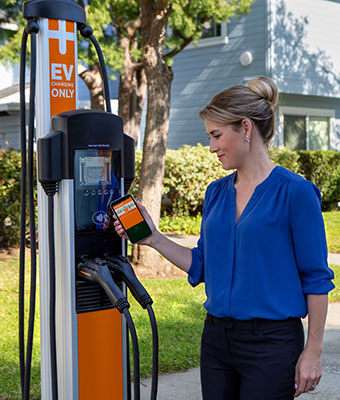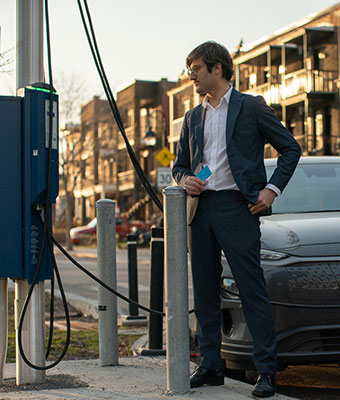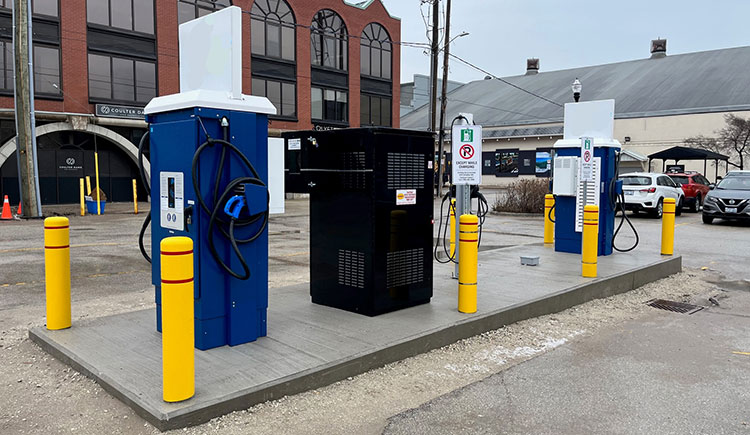RTO7 GoEV Funding Program
Please note: The RTO7 GoEV Program has now been fully allocated and we are happy to report that 274 EV chargers have been installed. The vast majority of these are in-region and will play a key role in strengthening EV travel and tourism by making it easier for visitors to explore, stay and spend in our communities.
The Government of Canada has set an ambitious and mandatory target of every new light-duty vehicle and passenger truck being zero-emission by 2035. RTO7’s GoEV funding program will provide funding of up to 50% of eligible costs toward qualified electric vehicle (EV) charging stations installed by June 2025.
This initiative will help to:
-
Spur EV adoption by the public;
-
Increase tourists’ (and residents’) confidence when travelling within BruceGreySimcoe;
-
Prioritize sustainability, enhancing the appeal of the region as an environmentally responsible destination, and attracting like-minded people;
-
Contribute to employee retention and host organizations’ environmental, social and corporate governance initiatives; and
-
Create positive change, contributing to the creation of a more sustainable, resilient, and economically vibrant community (and transportation ecosystem).
Further information, steps to apply including a link to the application form and FAQs are provided below. We recommend reading through all materials/links to ensure you don't miss anything important.
Click here to read the News Release from February 21, 2024
Eligible applicants

-
Recipients representing tourism assets within Bruce, Grey & Simcoe Counties will be selected through a transparent process, based on demand
-
Provided local objectives are met, consideration may be given to strategic/corridor projects that align with RTO7’s mandate
-
Eligible organizations must be incorporated or registered and can be for-profit or not-for-profit such as: companies; industry associations; Indigenous and community groups; academic institutions; provincial, territorial, regional or municipal governments or their departments or agencies; research associations and gas or electricity utilities.
-
Non-eligible recipients include federal government entities including departments, agencies and crown corporations. Also, individuals are not eligible applicants for this program; the Ultimate Recipient of eligible funding must be an organization.
Eligible locations/uses
-
Public areas intended for public access including attractions, retail, restaurants, marinas, grocery stores, accommodators, parks and trail systems, service stations, professional service offices, etc.;
-
On-Street Parking and public (municipal) lots;
-
Workplaces parking where electric vehicle chargers are primarily used by employees and visitors;
-
Multi-Unit Residential buildings with at least 3-unit dwellings e.g. condominiums, townhouse complexes, apartments;
-
Light-Duty Fleets used in support of business activities, including taxis and delivery trucks.
-
Private residences including businesses registered at such locations are not eligible for this program.
Please note that this Program is for charging for “on-road” vehicles and as such, behind the gate vehicles, boats, Zambonis, tractors, forklifts, etc. are not eligible.
Funding Maximums & Eligible Costs
-
Qualified applicants may receive funding of up to 50%* of maximum total eligible costs for the purchase and installation of qualified EV charging equipment;
-
Total funding is up to $100,000 per application.
*Indigenous businesses and communities may receive up to 75% of maximum total eligible costs
Eligible costs include:
-
EV chargers, related equipment and infrastructure;
-
Installation (including purchased equipment, technical services, licences and permits, construction and related direct costs);
-
Rental or leasing costs;
-
HST net of any rebates;
-
Professional services, such as engineering, construction, installation; and
-
Environmental assessment costs.
Eligible Equipment

Level 2 Charging
-
Level 2 is the most common type of charger – powered by a common 240-Volt, up to 30 Amps, AC power source, similar to that of household appliances
-
Useful for longer charging opportunities such as at public location day parking, overnight charging at commercial accommodations (such as hotels/resorts, etc.), workplace day/night parking, commuter parking, etc.
-
Level 2 (208 / 240 V) connectors 3.3kW to 19.2kW
-
Approximate EV Charging Time (adding 150-200km vehicle range) - 3 to 8 hours charging duration
-
Up to 50% of eligible costs, to a maximum of $5,000 per connector
Level 3 Charging
-
Level 3 chargers are typically powered by a 480-600 Volt AC power source rated over 30 Amps and up to 300 Amps
-
Most suitable capacity for enroute travel and destination stops such as convenience stops, service stations, restaurants, shopping complexes, wherever EV drivers need a convenient quick charge
-
3 power levels ranging from 20kW to 100kW+
-
Approximate EV Charging Time (adding 150-200km vehicle range) - under 30 minutes
-
Up to 50% of eligible costs, to a maximum of $15,000 to $75,000 per charger depending on power level

Funding Summary
|
Eligible Electric Vehicle Technology Type
|
Maximum funding per unit installed
|
Maximum funding per unit installed for Indigenous businesses and communities
|
|
Level 2 connectors
(3.3 kw to 19.2 kW)
|
Up to 50% of total eligible expenditures of the Sub-Project, to a maximum of $5,000 per connector
|
Up to 75% of total eligible expenditures of the Sub-Project, to a maximum of $7,500 per connector
|
|
Fast charger
(20 kW to 49 kW)
|
Up to 50% of total eligible expenditures of the Sub-Project, to a maximum of $15,000 per fast charger
|
Up to 75% of total eligible expenditures of the Sub-Project, to a maximum of $22,500 per charger
|
|
Fast charger
(50 kW to 99 kW)
|
Up to 50% of total eligible expenditures of the Sub-Project, to a maximum of $50,000 per fast charger
|
Up to 75% of total eligible expenditures of the Sub-Project, to a maximum of $75,000 per charger
|
|
Fast charger
(100 kW to 199 kW)
|
Up to 50% of total eligible expenditures of the Sub-Project, to a maximum of $75,000 per fast charger
|
Up to 75% of total eligible expenditures of the Sub-Project, to a maximum of $100,000 per charger
|
Other requirements
-
Charging stations must be a permanent and new installation
-
Chargers will be required to communicate to other stations and/or to a server or the cloud through cellular/wireless signal or connected vehicle communications using software to report on usage and/or other capabilities such as providing real-time status of charging stations;
-
Chargers will be commercially available and certified for use in Canada (for example, CSA, ULC, UL, Interlink).
-
Level 2 chargers will have a SAE J1772 standard or NACS connector type.
-
Direct Current Fast Chargers must be SAE J1772 Combo (CCS) or NACS charging connector.
-
NACS JS3400 or proprietary connector types will represent a maximum of 75% of all charging connectors installed at the same Sub-Project site.
3 Easy Steps to Apply
1. Get Selected for Funding
-
Complete the RTO7 GoEV Project Application to begin your pre-approval process. Our deadline for submissions is June 1, 2024 (please note that after May 1, 2024 the program eligibility may be expanded to consider applications beyond RTO7's focused audience of tourism assets within Bruce, Grey & Simcoe Counties, so it is highly recommended to get your applications in before this).
-
Following submission of your application, you will receive a follow-up phone call or email from the Program Manager requesting clarification of anything required.
-
We will review this information and let you know the level of funding your project might qualify for.
2. Commit to the project within 60 days
-
After you receive pre-approval, you will have 60 days to secure your share of the funding, to sign the RTO7 GoEV Project Agreement and start work on the project
3. Complete your project within one year of application selection
-
Selected projects will have one year within the date of notification of selection to have the charging station in service
-
After your project is complete, we will ask you to provide supporting invoices, proof of payment, as well as evidence of installation (vendor in-service commissioning/confirmation and photos)
-
Once we have reviewed and approved your completed project for funding, you will receive payment for your rebate amount
There are limited funds available and we anticipate high demand - Get started on your application today!
If you have any questions about the program that aren’t answered in the Frequently Asked Questions, email us at goev@rto7.ca and we will respond to your question typically within 2-3 business days.